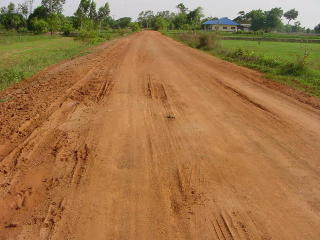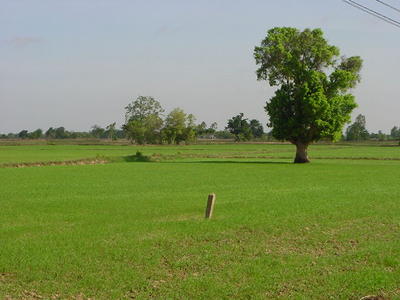
In Isan the joke is, "Our seasons are simple: we have hot, hotter, and hottest."
But actually, we do have three very distinct seasons mixed in with the heat. [Following references to temperature are in Fahrenheit.]
NOVEMBER, DECEMBER, JANUARY
"WINTER"
"WINTER"
Lower humidity (60-70%), 80 degrees in the afternoon, but gets down to a frigid 60-70 degrees at night. Believe it or not, it feels VERY cold at those temperatures. People walk around in big winter coats, neck scarves, knitted caps, and ear muffs! At first it was funny. I sported my short-sleeved shirts the first year while my students looked like Santa's elves bundled up against the cold of the North Pole.
Well, 2-1/2 years later, I now wear my old ski coats I dragged along with me from Washington State.
These "cold" temperatures are unique to Isan, as nothing blocks the cold winds that sweep down from China. Bangkok, central, and south Thailand remain pretty warm (80's-90's day and night). The staple of life, rice, ripens in November-December and is harvested at that time.
FEBRUARY
Transition to Next Season
Transition to Next Season

MARCH, APRIL, MAY
SUMMER
(Yep, right. No spring)
(Yep, right. No spring)
Extremely hot (105-110) and humid (90% and higher), no rain. Despite the humidity, the land still dries out. Everything dry as a bone, and everything dies but the trees. Villages run out of water, and children scrounge for little crabs, frogs, lizards and eels to eat at the bottom of dry cracks in the hard soil. It's a very harsh time when nature seems bent on crushing all the life out of the land and its inhabitants.
This extreme heat is also unique to Isan. I lived a couple summers in Red Bluff, California (where it hit a record 124-degrees my second summer), so I was psychologically prepared for it. But not the humidity!
JUNE
Transition to Next Season
Transition to Next Season

JULY, AUGUST, SEPTEMBER
RAINY SEASON
Monsoons
RAINY SEASON
Monsoons
Temperatures moderate to 80-'s and 90's. Everything very suddenly turns verdant green, the rice fields look like golf courses (tall grass!), and the water buffalos smile. Many tree fruits ripen at this time. This is the main rice-growing season, and the harvest comes next season.
All of Asia (from India to China and Japan) experiences these monsoons. Japan gets the added "perk" of typhoons at this time.
OCTOBER
Transition to Next Season
Transition to Next Season
**************
It's a very different seasonal cycle from that which I was used to in any place I've lived in the USA (Washington, California, Michigan). What's fun to observe is how everything seems to be more closely tied to the seasons and the land, here. Almost every holiday is seasonally-related, or agriculturally-related; usually dealing with praying for future rain, thanking nature for current rain, or the activity of harvest time.
**************
SIDEBAR: Another interesting sidelight is that, this close to the equator, the days and nights are equal (12 hours each) year around. The sun consistently sets at 6 and rises at 6. It affects my sleeping habits. I sleep about 2 hours more a night here than I did in the USA. And, unlike being close to big population centers (as in the Seattle area), it gets DARK when the sun sets on moonless nights. When the electricity goes out (as it frequently does), you can't see your hand in front of your face. It's weird. One little birthday-cake candle throws an amazing amount of light in that situation!

It gives new visual images to the child’s song “This Little Light of Mine.”
No comments:
Post a Comment